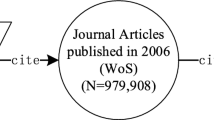Abstract
We report progress on new developments in the breakthrough paper indicator, which allows early selection of a small group of publications which may become potential breakthrough candidates based on dynamics of publication citations and certain qualitative characteristics of citations. We used a quantitative approach to identify typical citation patterns of highly cited papers. Based on these analyses, we propose two forecasting models to select groups of breakthrough paper candidates that exceed high citation thresholds five years post-publication. Here we study whether interdisciplinarity in the subject categories or geographical diversity serve as possible measures to improve ranking of breakthrough paper candidates. We found that ranked geographical diversities of known breakthrough papers have equal or better ranks than corresponding citations ranks. This allows us to apply additional filtering for better identifications of breakthrough candidates. We studied several interdisciplinarity indices, including richness, Shannon index, Simpson index, and Rao-Stirling-Porter index. We did not find any correlations between citation ranks and ranked interdisciplinarity indices.



Similar content being viewed by others
Notes
For example, compare more than 97,000 publications in the WOS “Material Science, Multidisciplinary” subject category versus 585 publications in “Literature, African, Australian, Canadian” in 2011.
References
Abrahams, E., et al. (1979). Scaling theory of localization: absence of quantum diffusion in two dimensions. Physical Review Letters, 42(10), 673–676.
Aversa, E. S. (1985). Citation patterns of highly cited papers and their relationship to literature aging: a study of the working literature. Scientometrics, 7, 383–389.
Barábasi, A.-L., & Albert, R. (1999). Emergence of scaling in random networks. Science, 286, 509–512.
Chen, Chaomei, et al. (2009). Towards an explanatory and computational theory of scientific discovery. Journal of Informetrics, 3, 191–209.
Conover, W. J. (1999). Practical nonparametric statistics (3rd ed.). New York: John Willey & Sons.
De Solla Price, D. J. (1965). Network of Scientific Papers. Science, 149, 510–515.
De Solla Price, D. J. (1976). General theory of bibliometric and other cumulative advantage processes. Journal of the American Society for Information Science, 27(5–6), 292–306.
Distel, R. J., et al. (1987). Nucleoprotein complexes that regulate gene expression in adipocyte differentiation: direct participation of c-fos. Cell, 49(6), 835–844.
Edwards, R. G., & Steptoe, P. C. (1978). Birth after reimplantation of a human embryo. Lancet, 312(8085), 366.
Frenken, K., et al. (2005). The citation impact of research collaboration in science-based industries: A spatial-institutional analysis. Papers in regional science, 89(2), 351–371.
Garfield, E. (1955). Citation indexes for science: a new dimension in documentation through association of ideas. Science, 122(3159), 108–111.
Garfield, E. (1972). Citation analysis as a tool in journal evaluation: journals can be ranked by frequency and impact of citations for science policy studies. Science, 178, 471.
Garfield, E. (1990). Who will win the nobel prize in economics: here is a forecast based on citation indicators. Current Contents, 11, 3–7.
Garfield, E., & Welljams-Dorof, A. (1992). Of nobel class: a citation perspective on high impact research authors. Theoretical Medicine, 13, 117–135.
Geller, N. L., de Cani, J. S., & Davis, R. E. (1981). Lifetime-citation rates: a mathematical model to compare scientists’ work. Journal of the American Society for Information Science, 32(1), 3–15.
Glänzel, W., et al. (2003). Better late than never? On the chance to become highly cited only beyond the standard bibliometric time horizon. Scientometrics, 58(3), 571–586.
Heck, R. F. (1968). Acylation, methylation, and carboxyalkylation of olefins by Group VIII metal derivatives. The Journal of the American Chemical Society, 90(20), 5518–5526.
Katz, J. S. (1994). Geographical proximity and scientific collaboration. Scientometrics, 31, 31–43.
Katz, J. S., & Martin, B. R. (1997). What is research collaboration? Research Policy, 26(1), 1–18.
Kohn, W., & Sham, L. J. (1965). Self-consistent equations including exchange and correlation effects. Physical Review Letters, 140(4A), A1133–A1138.
Leydesdorff, L., & Rafols, I. (2011). Indicators of the interdisciplinarity of journals: diversity, centrality, and citations. Journal of Informetrics, 5, 87–100.
Merton, R. K. (1968). Matthew effect in science. Science, 159(3810), 56–63.
Nalimov V.V. and Mul’chenko Z.M. (1969): Naukometriya. Izuchenie nauki kak informatsionnogo protsessa (Scientometrics. Study of science as an information process.) Moscow: Nauka, 192 pgs (Available in English: http://www.garfield.library.upenn.edu/nalimov/nalimovmeasurementofscience/book.pdf).
Novoselov, K. S., et al. (2004). Electric field effect in atomically thin carbon films. Science, 306(5696), 666–669.
Pendlebury, D. (1989). The 1989 nobel prize in medecine: 20 who desrve it. Scientist, 3(19), 14–15.
Ponomarev, I. V., et al. (2014). Predicting highly cited papers: A method for early detection of candidates breakthroughs. Technological Forecasting and Social Change, 81, 49–55.
Porter, A. L., et al. (2007). Measuring researcher interdisciplinarity. Scientometrics, 72, 117–147.
Rafols, I., & Meyer, M. (2010). Diversity and network coherence as indicators of interdisciplinarity: case studies in bionanoscience. Scientometrics, 82, 263–287.
Rao, C. R. (1982). Diversity, its meausrement, decomposition, apportionment and analysis. Sankhya: The Indian Journal of Statistics, 44, 1–21.
Redner, S. (2005). Citation statistics from 110 years of Physical Review. Physics Today, 58, 49–54.
Rousseau, L., & Egghe, R. (1990). Introduction to informetrics: quantitative methods in library, documentation and information science. Amsterdam: Elsevier.
Small, H. G. (1973). Co-citation in the scientific literature: A new measure of the relationship between two documents. Journal of the American Society for Information Science, 24, 265–269.
van Raan, A. F. J. (2000). On growth, ageing, and fractal differentiation of Science. Scientometrics, 47, 347–362.
Weinberg, S. (1973). A model of leptons. Physical Review Letters, 19(21), 1264–1266.
Acknowledgments
We are very thankful to Y. Seger for editorial assistance.
Author information
Authors and Affiliations
Corresponding author
Rights and permissions
About this article
Cite this article
Ponomarev, I.V., Lawton, B.K., Williams, D.E. et al. Breakthrough paper indicator 2.0: can geographical diversity and interdisciplinarity improve the accuracy of outstanding papers prediction?. Scientometrics 100, 755–765 (2014). https://doi.org/10.1007/s11192-014-1320-9
Received:
Published:
Issue Date:
DOI: https://doi.org/10.1007/s11192-014-1320-9




